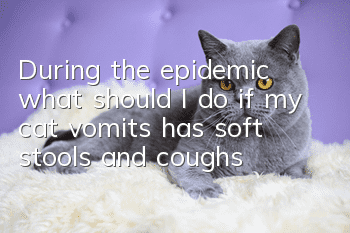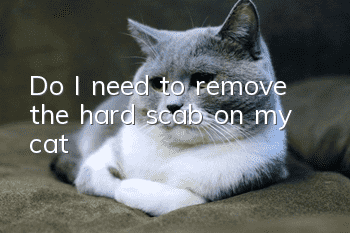During the epidemic, what should I do if my cat vomits, has soft stools, and coughs?

I find that my cat occasionally vomits, has soft stools, and coughs... Should I go to the hospital? On the one hand, I am worried that going out will make the cat stressed; on the other hand, I am afraid of delaying the condition... In addition, the epidemic keeps recurring, and it is difficult to go out. I am also worried about increasing the risk of infection for myself and my cat...what should I do? Don't worry, let's see what mild symptoms the cat has that can be treated and observed at home.
1. Cat’s soft/loose stool
How to identify
If you find that your cat’s feces cannot remain intact and appear mushy or watery when shoveling, your cat has diarrhea. In addition, a normal cat's poop will be dry and hard. If the poop comes out one by one, it is actually normal. If the poop deforms when pressed lightly, it means the poop is soft. Common causes include: dietary allergies, bacterial and viral infections, parasites, gastrointestinal diseases, tumors, etc.
What to do
▌If the cat has normal spirit and appetite, but has soft or loose stools:
You can feed small amounts first and multiple times to avoid overeating at one time;
Avoid feeding too much food with high fat content (such as nutritional paste/canned snacks/table food, etc.);
At the same time, probiotics can be given to condition the intestines;
Ensure adequate drinking water;
▌If the stool is completely unformed or watery and loose:
You can take montmorillonite powder or kaolin to stop diarrhea. (For example, diarrhea caused by parasitic infection may recur after stopping the drug)
▌When serious bacterial infection, parasitic infection and other abnormalities occur, it may be necessary to use together:
Anthelmintics, bismuth subcarbonate, metronidazole, Sono, Mafo, etc.
2. Vomiting undigested cat food
How to identify
Vomiting refers to the reflexive ejection of stomach contents through the mouth. The prodromal symptoms include nausea (salivation, lip licking, etc.), retching, swallowing movements, abdominal contraction, etc.
The difference between vomiting, regurgitation and coughing
When the master is suspected of "vomiting", the poop shoveler can observe the following details at home and make a preliminary judgment. At the same time, it is recommended to quickly take out your mobile phone and record the process to facilitate communication with the doctor later.
Vomiting: Abdominal contraction is severe, the vomitus is mostly digested cat food or mixed bile (mostly yellow mucus-like liquid), and the movements look relatively complicated.
During the epidemic, what should I do if my cat vomits, has soft stools, and coughs?
@ Cat Research Institute Hospital Photographed
Reflux: no unnecessary action (alsoThere is no "rock before release"), the cat opens its mouth and the food comes out of the mouth, usually undigested cat food.
Coughing: The cat will make a "crack-crack" sound, its abdomen will rise and fall greatly, nothing will flow out of its mouth, it will gasp, and some cats may also hiccup.
The main reasons include: hairy bulb syndrome, changes in environment and food, gastroenteritis, abnormal liver and kidney function, accidental ingestion of foreign bodies, etc.
What to do
▌ If a cat vomits undigested food and is in good spirits: you can fast for 2 to 3 hours first and observe whether vomiting continues; if the cat has the habit of vomiting hair balls, you can feed it hair-balls. ointment and observe whether the cat has appetite and whether vomiting occurs again;
▌If vomiting no longer occurs and there is appetite: easy-to-digest food can be given in small amounts and frequently.
▌If there is no more vomiting on the same day, but mild continuous vomiting still occurs the next day (vomiting 1 to 2 times a day): You can feed Weiculin (repair the gastrointestinal mucosa) and/or Serenin (anti-vomiting) , for close observation.
3. Constipation
How to identify
Constipated cats may have one or more of the following symptoms:
Cats defecate less and may find dry and hard feces in the litter box;
The cat repeatedly goes to the litter box to sit and urinate normally, but can only pass a small amount of loose stool;
Palpate the cat’s posterior abdomen and you can feel a hard tubular structure (feces accumulated in the intestines);
Severe constipation may also cause depression, anorexia, weakness, vomiting, etc. in animals.
What to do
▌If the cat urinates normally but has a defecation posture but cannot pass stool: you can increase the amount of water it drinks first; feed high-fiber foods such as steamed pumpkin, and apply more hair cream;
▌If constipation is severe: lactulose can be fed, 0.5~1ml/kg once, no more than three times a day; it can also be combined with the intestinal motility agent cisapride.
4. Blood in stool
How to identify
Stool with bright red blood or blood clots attached, or tarry stool.
During the epidemic, what should I do if my cat vomits, has soft stools, and coughs?
Blood in the stool may be caused by parasitic infection, improper diet, colon/proctitis, perianal diseases, etc.
What to do
▌Don’t panic when you find this situation, you can give probiotics first; check the cat’s immunity and deworming status, and choose anthelmintic drugs for deworming;
▌Change the cat’s diet appropriately to see if there is anyImprovement; If the blood in the stool does not improve the next day, or there is still blood in the stool for 3 consecutive days, it is recommended to contact the doctor as soon as possible.
5. Occasionally sneezing/coughing
How to identify
The treatment plan is similar. Pay attention to whether the cat has nasal secretions. Common causes of sneezing in cats are mainly: the presence of irritants (perfume, dust, pollen), bacteria, viral infections, nasal tumors, etc. in the environment.
What to do
▌If the spirit and appetite are normal, the sneezing frequency is less than five times a day, there is no serious continuous sneezing, and there is no obvious nasal secretions: you can pay attention to keeping warm, reduce stress, ensure nutritional supply, and enhance resistance (high-quality diet, you can Give lactoferrin at the same time);
▌If the cat has a good spirit and appetite but has white or yellow nasal secretions: Oral Sunuo or Kechuanning can be taken twice a day; at the same time, use atomization and keep warm (Note: This method is for cat upper respiratory tract infection) Symptomatic treatment plan, the cause of the disease cannot be determined).
▌If the cat does not improve after 3 to 5 days of the above care, or develops purulent secretions: After communicating with the doctor, you can try oral doxycycline and famciclovir for treatment.
6. Increased eye secretions
How to identify
If you find that your cat has "watery eyes", severe tear stains, frequent squinting, red and swollen eyes, corneal ulcers, large and small eyes, etc., most of the cats have eye discomfort.
During the epidemic, what should I do if my cat vomits, has soft stools, and coughs?
Common causes include: foreign bodies, allergies, inverted eyelashes, third eyelid hyperplasia, rhinitis, sinusitis, nasolacrimal duct inflammation, trauma, etc.
What to do
▌If the cat is in good spirits and has good appetite, but simply sheds tears or has no obvious abnormalities in the eyes: it is recommended to wear an Elizabethan ring to prevent the cat from scratching itself and further damaging the eyes; you can try to use artificial tears, eye cleansing, and moisturizing. Eye drops, etc. can be used to clean the eyes and relieve eye discomfort;
▌If the color of the cornea or iris changes and there is purulent eye secretion: eye drops to control conjunctivitis can be given, such as tobramycin eye drops, neomycin eye drops, etc., once every 2 hours, once a day Four times, administer for 2-3 days to see if there is any improvement.
▌If there is no obvious improvement, or the eyes are cloudy: It is recommended to stop the medication immediately and contact the doctor in time. It is best to make an appointment as soon as possible.
7. Skin or ear canal problems
How to identify
During the epidemic, what should I do if my cat vomits, has soft stools, and coughs?
Ear mites often parasitize the external auditory canal of cats, causing severe itching and inflammation.The dog keeps scratching and develops symptoms such as hair loss, epidermal peeling, and a large amount of coffee grounds-like earwax in the ear canal. Ringworm refers to a cat being infected by a fungus, which appears as round, bald patches of ringworm. The cat usually does not itch.
During the epidemic, what should I do if my cat vomits, has soft stools, and coughs?
What to do
▌If the cat licks or scratches frequently: Wear an Elizabethan collar to prevent further damage and infection. Generally, skin problems are not serious;
▌If the cat has not been dewormed externally for a long time, it can be dewormed first (Dapaiai, Mo Aijia, etc.), and ear bleaching can be used to clean the ear canal;
▌If the skin has epidermal bleeding or damage, it can be wiped and disinfected with iodophor;
▌It is not recommended to use topical medicines at will when the situation is unknown.
8. Mild trauma
How to identify
Common trauma injuries to cats include the head, limbs, back and tail. Cats are used to hiding pain. If the cat is limping, avoiding, or licking itself excessively, suspect the possibility of trauma. Common causes include: surgical wound rupture, fighting, indoor accidental injuries, etc.
What to do
▌If the cat is accidentally scratched by a sharp object or bleeds from nail scratches: First, wear a collar on the cat (to prevent accidental injury to people due to pain when checking the wound, and to prevent infection of the licking wound); with the help of family members Press with cotton balls to stop bleeding, or use Yunnan Baiyao hemostatic powder to stop bleeding; clean the hair around the wound, rinse and disinfect with saline or iodine solution, apply iodophor twice a day for minor scratches, and povidone-iodine cream for one day if it is more severe. twice.
Note: If the wound is too deep, hurts the organs, or cannot stop the bleeding, you need to find a professional to deal with it in time.
9. Cat’s blood in urine
How to identify
If the cat has improper urination (urinating outside the litter box), blood in the urine, painful urination, smaller urine balls, etc., the cat should pay special attention! Especially in male cats, complete urethral obstruction may occur. The risk!
What to do
▌On the premise of minimizing stress;
▌Make sure the cat drinks enough water. Daily water intake = body weight * (50-60ml); at the same time, pay close attention to the cat’s urination. If there are many cats in the environment, the sick cat needs to be isolated and observed.
▌If you urinate frequently but no urine is discharged at all, you need to go to the doctor directly!
- How to comfort a cat with irritated fur?
- What is the function of cat meat pads?
- Why is the cat shivering after vaccination? Is it a drug allergy?
- Why do I have soft stool after eating canned Miao Xian Bao?
- Precautions for internal and external deworming of cats
- How does a cat adapt to its new home when it first arrives?
- Cat plague will get better after a few days
- Can cats with autism heal themselves?
- Kitten eating habits: feeding frequency is the key
- Small animal ophthalmic emergencies and treatment - overview



